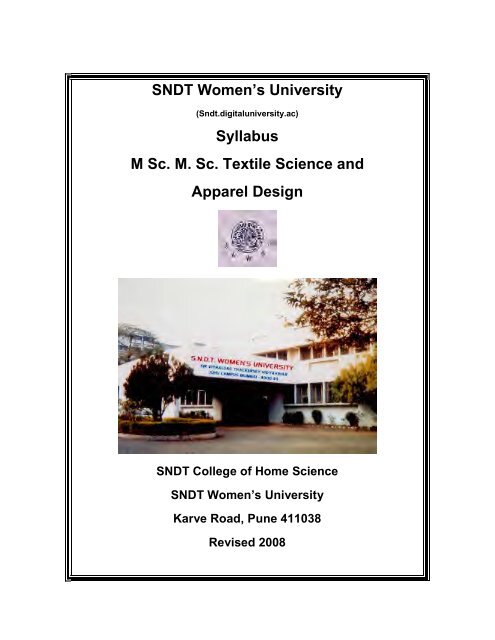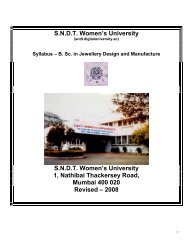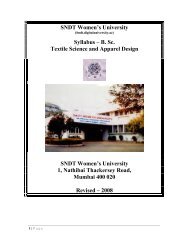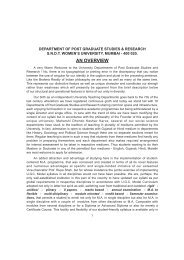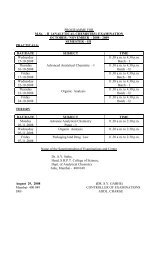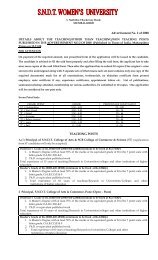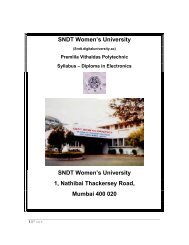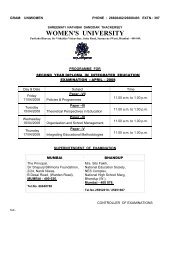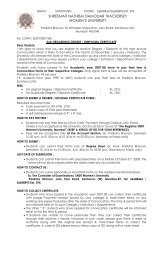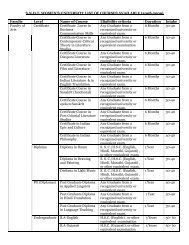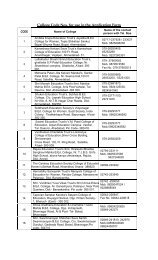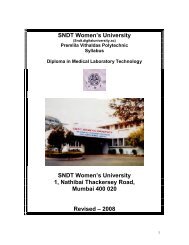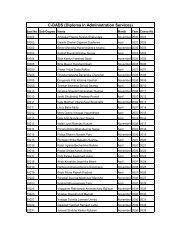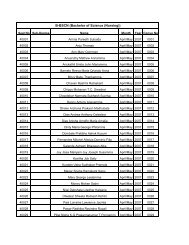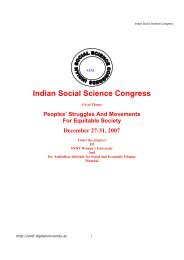SNDT Women's University Syllabus M Sc. M. Sc. Textile Science and
SNDT Women's University Syllabus M Sc. M. Sc. Textile Science and
SNDT Women's University Syllabus M Sc. M. Sc. Textile Science and
Create successful ePaper yourself
Turn your PDF publications into a flip-book with our unique Google optimized e-Paper software.
<strong>SNDT</strong> Women’s <strong>University</strong>(Sndt.digitaluniversity.ac)<strong>Syllabus</strong>M <strong>Sc</strong>. M. <strong>Sc</strong>. <strong>Textile</strong> <strong>Sc</strong>ience <strong>and</strong>Apparel Design<strong>SNDT</strong> College of Home <strong>Sc</strong>ience<strong>SNDT</strong> Women’s <strong>University</strong>Karve Road, Pune 411038Revised 2008
Eligibility: C<strong>and</strong>idate with an overall average of B Grade or equivalent (55%) marks inB.<strong>Sc</strong> <strong>Textile</strong> <strong>Sc</strong>ience & Apparel Design, B.<strong>Sc</strong> Apparel Design, B. <strong>Sc</strong> <strong>Textile</strong>s & Clothing,B<strong>Sc</strong> Fashion Design, B<strong>Sc</strong> Fashion Apparel Design, B.<strong>Sc</strong> Composite (Home <strong>Sc</strong>ience) areeligible for this course.Students with the following undergraduate degrees viz., B.<strong>Sc</strong> Apparel Design, B<strong>Sc</strong> FashionDesign, B<strong>Sc</strong> Fashion Apparel Design, B.<strong>Sc</strong> Composite (Home <strong>Sc</strong>ience) are eligible providedthey complete the required prerequisites by the end of Semester II i.e FY M<strong>Sc</strong>:Prerequisites required:<strong>Textile</strong> Testing, <strong>Textile</strong> Chemistry, Weaving (theory & practicals)Objectives:• To impart knowledge <strong>and</strong> develop capacities of the students through state of art highereducation with indepth study of <strong>Textile</strong> Technology <strong>and</strong> Garment Production in theareas of Chemical Processing of <strong>Textile</strong>s, Quality Control in <strong>Textile</strong>s <strong>and</strong> Apparels,Knitting Technology <strong>and</strong> Knitwear Design <strong>and</strong> Grading <strong>and</strong> Draping of Patterns.• To develop the process of critical <strong>and</strong> analytical thinking <strong>and</strong> encourage the students topursue further Studies <strong>and</strong> Research in the areas of <strong>Textile</strong>s <strong>and</strong> Apparels.• The over all emphasis is, to enrich the knowledge base, enhance research aptitude <strong>and</strong>to provide the students with inbuilt confidence in their professional field <strong>and</strong> cuttingedge in the global scenario.
SYLLABUS FORMATFaculty ame: Home <strong>Sc</strong>ience.Course ame: M. <strong>Sc</strong>. <strong>Textile</strong> <strong>Sc</strong>ience <strong>and</strong> Apparel Design.SCHEME: Semester ISr.no Subjects L Cr P/T D TP Internal P/V T1 Research Methods & Statistics I 4 4 - 2.5 75 25 - 100Theory2 Research Methods & Statistics I - 2 4 - - 50 - 50Practical3 Quality Control for <strong>Textile</strong>s & 4 4 - 2.5 75 25 - 100Apparel FabricsTheory4 Quality Control for <strong>Textile</strong>s & - 2 4 - - 25 25 50Apparel FabricsPractical5 <strong>Textile</strong> Chemistry <strong>and</strong> Processing 4 4 - 2.5 75 25 - 100of <strong>Textile</strong>sTheory6 <strong>Textile</strong> Chemistry <strong>and</strong> Processing - 2 4 - - 25 25 50of <strong>Textile</strong>sPractical7 Advance Garment Design & - 4 8 - - 50 50 100Construction TechniquesPracticalTotal 12 22 20 7.5 225 225 100 550SCHEME: Semester IISr.no Subjects L Cr P/T D TP Internal P/V T1 Research Methods & Statistics II 4 4 - 2.5 75 25 - 100Theory2 Research Methods & Statistics II - 2 4 - - 50 - 50Practical3 Woven Fabric Structures & 4 4 - 2.5 75 25 - 100Fabric AnalysisTheory4 Woven Fabric Structures & - 2 4 - - 25 25 50Fabric Analysis.Practical5 History of Fashion & Fashion 4 4 - 2.5 75 25 - 100DesignTheory6 History of Fashion & FashionDesign- 2 4 - - 25 25 50
Practical7 Technical <strong>Textile</strong>s4 4 - 2.5 75 25 - 100TheoryTotal 16 22 12 10 300 200 50 550SCHEME: Semester IIISr.no Subjects L Cr P/T D TP Internal P/V T1 Knitting Technology & Knitwear 4 4 - 2.5 75 25 - 100DesignTheory2 Knitting Technology & Knitwear - 4 8 - - 75 25 100Design.Practical3 Garment Production Technology 4 4 - 2.5 75 25 - 100Theory4 Grading- 4 8 - - 50 50 100Practical5 Dissertation OR Project - 2 4 - - - - -Total 8 18 20 5 150 175 75 400SCHEME: Semester IVSr.no Subjects L Cr P/T D TP Internal P/V T1 Research Application in <strong>Textile</strong>s& Clothing.Practical2 DrapingPractical3 Fashion Marketing, Retailing &Merch<strong>and</strong>ising.Theory- 2 4 - - 50 - 50- 4 8 - - 75100254 4 - 2.5 75 25 - 1004A Dissertation OR Project. - 6 12 - - 100 100 2004BI- Project.II-Elective [Practical].Total1+2+3+4ATotal1+2+3+4B--4284----75257525150504 16 24 2.5 75 250 125 4504 16 24 2.5 75 250 125 450L = No. of Lectures / week, P / T = Practical / Tutorial in hrs, D = Duration of Theory paperfor Examination in hrs, TP = Theory Paper-marks, TW = Term Work - marks,P/V = Practical / Viva Voce - marks, T = Total.
SEMESTER 1RESEARCH METHODS AD STATISTICS I (Theory)Objectives:This course will enable students to:1. develop a scientific approach <strong>and</strong> know the processes of research2. develop the competence for selecting methods <strong>and</strong> tools appropriate for research topics3. underst<strong>and</strong> concepts of statistical measures of central tendency, dispersion, variability <strong>and</strong>probabilitySr.no Subjects L Cr P/T D TP Internal P/V T1 Research Methods <strong>and</strong>Statistics-I(Th)4 4 - 2.5 75 25 - 100ContentsSr.NoBlock1Block2Block3Block4Topic <strong>and</strong> DetailsThe Research ProcessUnit 1. <strong>Sc</strong>ientific approach to enquiry in comparison to native,common sense approachUnit 2. Knowledge, theory <strong>and</strong> researchUnit 3. Role, need <strong>and</strong> scope of research in Home <strong>Sc</strong>ienceIntroduction to StatisticsDefinition, conceptual underst<strong>and</strong>ing of statistical measures,popular concepts <strong>and</strong> misuse of statisticsSteps in the Research ProcessUnit 1. Identifying interest areas <strong>and</strong> prioritizingUnit 2. Selection of the topic <strong>and</strong> considerations in selectionUnit 3. Review of related literature <strong>and</strong> researchUnit 4. Concepts, hypotheses <strong>and</strong> theoriesUnit 5. Research DesignUnit 6. Research questions, objectives <strong>and</strong> assumptionsUnit 7. Hypothesis- meaning, attributes of a sound hypothesis,Stating the hypothesis <strong>and</strong> types of hypothesisHypothesis testing- null hypothesis, sample distribution, levelof significance, critical regions, Type I <strong>and</strong> Type II errorsUnit 8. Variables- types of variables including discrete <strong>and</strong>continuous variablesUnit 9. Conceptual definitions <strong>and</strong> operational definitionsTypes of ResearchUnit 1. Basic <strong>and</strong> applied research, Qualitative <strong>and</strong>Quantitative research (brief review of differences)Unit 2. Historical researchUnit 3. Descriptive research methods – survey, case study,correlational study, content analysis, causal-comparativeresearchUnit 4. Analytic studies- pre-experimental, experimentalNo of Percentlectures weigtage2 528-10 2010 15
Block5Block6Block7Block8research, quasi experimental researchUnit 5. Qualitative research, ethnographyUnit 6. Evaluative research- general characteristics, use ofqualitative methods in enquiry<strong>Sc</strong>ope <strong>and</strong> importance in Home <strong>Sc</strong>ienceTools for Data CollectionUnit 1.Primary <strong>and</strong> secondary methods of data collectionUnit 2.Different types of questionnaires, rating scales, checklists, schedules, attitude scales, inventories, st<strong>and</strong>ardized tests,interviews, observationUnit 3. Development of tools, estimation of reliability <strong>and</strong>validity of toolsUnit 4. Procedure for preparation of the tool, administration oftools for data collectionUnit 5. Procedure for data collectionUnit 6. Planning for data analysis-coding of responsesNormal Distribution <strong>and</strong> its PropertiesUnit 1. Normal distributionUnit 2. Binomial distributionUnit 3. Probability, use of normal probability tables, area undernormal distribution curveSamplingUnit 1. Rationale, characteristics- meaning, concept ofpopulation <strong>and</strong> sample, <strong>and</strong> utilityUnit 2. Types of sampling <strong>and</strong> generalizability of resultsUnit 3 Probability sampling- simple r<strong>and</strong>om sample,systematic r<strong>and</strong>om sample, stratified r<strong>and</strong>om sampling etcr<strong>and</strong>om<strong>and</strong> non-r<strong>and</strong>om samples, r<strong>and</strong>om numbers <strong>and</strong> useUnit 4. Non-probability sampling-purposive samples,incidental samples, quota samples, snowball samplesUnit 5. General consideration in determination of sample sizeData Management <strong>and</strong> AnalysisUnit 1. Quantitative analysis, descriptive statistics, inferentialstatistics : Uses <strong>and</strong> limitationsSummation sign <strong>and</strong> its propertiesUnit 2: Proportions, percentages, ratiosUnit 3.Measures of central tendency-mean, median, modearithmeticmean <strong>and</strong> its uses, mid – range, geometric mean,weighted meanMeasures of dispersion /variability- range, variance, st<strong>and</strong>arddeviation, st<strong>and</strong>ard error, coefficient of variation, Kurtosis,skewnessUnit 4. Grouped data-frequency distribution, histogram,frequency polygons, percentiles, quartiles, textiles, ogive10 204 108 1020 20
RESEARCH METHODS AD STATISTICS I (Practicals)Subjects L Cr P/T D TP Internal P/V T1 Research Methods <strong>and</strong>- 2 4 - - 50 - 50Statistics-I (Pr)Contents:Sr.Topic <strong>and</strong> DetailsNo1 Differentiate between investigative reporting <strong>and</strong> researchreport (with examples to be brought by students as exercise)2 Differentiate between (a) basic <strong>and</strong> applied research (Exerciseto be based on actual research papers published in accreditedjournals)(b) qualitative <strong>and</strong> quantitativeresearch3 Multidisciplinary nature of Home<strong>Sc</strong>ience – grounding ofHome<strong>Sc</strong>ience disciplines in various sciences <strong>and</strong>/orspecializations (Exercise: students to identify 3multidisciplinary topics with case discussion)4 Types of variablesHypothesis formations <strong>and</strong> research questions from Researchreadings – students identify hypothesis/research questions –Discussion5 Based on Journal contents discuss types of Research withexamples6 Students to brainstorm on areas/topics for Research in each ofthe focal areas of their specialization7 Construction of tools for data collection a) types of questionsb) Questionnaire c) interview schedule d) observation d)scales8 For a given topic students to frame <strong>and</strong> discuss the differentpossibilities of methods <strong>and</strong> tools9 Students to design a research study on a topic-1. specify type of research2. sample selection3. protocol/operationalization4. tools5. tests for statistical analysisNo oflectures22PercentWeigtage52 54 102-4 52-4 510 158 108 2010 Sample distribution <strong>and</strong> probability 6 511 Sampling 212 Data Management <strong>and</strong> AnalysisFrequency distributions, Measures of central tendency,measures of dispersion, variability12 20
ReferencesRESEARCH METHODS1. Bell, J. (1997): Doing Your Research Project: A Guide for First-time Researchers inEducation <strong>and</strong> Social <strong>Sc</strong>ience, Viva Books, New Delhi2. Bell, J. (1997): How to Complete Your Research Project Successfully: A Guide for FirsttimeResearchers, UBSPD, New Delhi.3. Bulmer, M.C. (1984): Sociological Research Methods: An Introduction, Macmillan,Hong Kong.4. Festinger, L. <strong>and</strong> Katz, D. (ed.) (1977): Research Methods in the Behavioral <strong>Sc</strong>iences,Amerind Publishing, New Delhi.5. Holloway, I. (1997): Basic Concepts of Qualitiative Research, Blackwell <strong>Sc</strong>ience,London.6. Jain, G. (1998): Research Methodology: Methods <strong>and</strong> Techniques, Mangal Deep, Jaipur.7. Kothari, C.R. (2000): Research Methodology: Methods <strong>and</strong> Techniques, WishwaPrakashan, New Delhi.8. Kumar, A. (1997): Social Research Method (The Art of <strong>Sc</strong>ientific Investigation), AnmolPublication, New Delhi.9. Kumar, A. (2002): Research Methodology in Social <strong>Sc</strong>iences, Sarup <strong>and</strong> Sons, NewDelhi.10. McBurney, D.H. (2001): Research Methodology, Thomson-Wadsworth, Australia.11. P<strong>and</strong>e, G.C. (1999): Research Methodology in Social <strong>Sc</strong>iences, Anmol Publication, NewDelhiStatistics1. GUPTA, S. (2001) “Research Methodology <strong>and</strong> Statistical Techniques”,Deep <strong>and</strong>Deep, New Delhi, 510p.2. HOODA, R.P. (2003) “Statistics for Business <strong>and</strong> Economics”, 3rd ed.,MacmillanIndia Ltd., Delhi, 855p.3. DEY, B.R. (2005) “Textbook of Managerial Statistics”, Macmillan India Ltd., Delhi,318p.4. FLEMING, M.C. & NELLIS, JOSEPH G. (1997) “The Essence of Statistics forBusiness”, Prentice-Hall of India, New Delhi, 270p.5. SARMA, K.V.S. (2001) “Statistics made Simple: Do it yourself on PC”, Prentice-Hall, New Delhi, 257p.6. CHAKRAVORTI, S.R. & GIRI, N. (1997) “Basic Statistics”, South Asian Pub.,NewDelhi, 271p.7. DAS, M.N. (1989) “Statistical Methods <strong>and</strong> Concepts”, New Age, New Delhi,256p.8. ELHANCE, D.N. (2000) “Fundamentals of Statistics [containing more than750solved <strong>and</strong> 1250 problems for review exercise]”, Kitab Mahal, Allahabad, 1523p.9. GOON, A. & GUPTA, M. & DASGUPTA, B. (2001) “Fundamentals of Statistics”,Vol.I & II, The World Press, Calcutta, 150p.10. GUPTA, S.P. (1996) “Practical Statistics”, 37th ed., S. Ch<strong>and</strong>, New Delhi, 563p.11. GUPTA, S.C. (2000) “Fundamentals of Statistics”, Himalaya Pub., Mumbai, 1343p.12. GUPTA, S.P. (2000) “Statistical Methods”, Sultan Ch<strong>and</strong> & Sons, New Delhi, 1428p.13. GUPTA, C.B. & GUPTA, V. (1973) “An Introduction to Statistical Methods”, Vikaspublishing house pvt. ltd., New Delhi, 829p.14. NAGAR, A.L. & DAS, R.K. (1997) “Basic Statistics”, 2nd ed., OUP, Delhi, 424p.15. SHENOY, G.V. & PANT, M. (2006) “Statistical Methods in Business <strong>and</strong> Social<strong>Sc</strong>iences”, Macmillan India Ltd., Delhi, 388p.
16. SPIEGEL, MURRAY R. (1998) “<strong>Sc</strong>haum's Outline of Theory <strong>and</strong> Problems ofStatistics”, 3rd ed., Tata McGraw-Hill Pub., New Delhi, 538p.17. TRIOLA, MARIO F. (1998) “Elementary Statistics”, 7th ed., Addison WesleyLongman, America, 804p.18. RICHARD A. (1992) “Applied Multivariate Statistical Analysis”, Prentice-Hall, NewDelhi, 642p.
SEMESTER IObjectives:Quality Control for <strong>Textile</strong>s <strong>and</strong> Apparel Fabrics (Theory)1. To develop an underst<strong>and</strong>ing of methods <strong>and</strong> techniques used to analyse textile fibers,yarns <strong>and</strong> fabrics for end use performance2. To acquire knowledge <strong>and</strong> underst<strong>and</strong>ing of various structural properties of textiles<strong>and</strong> relate them to end use fabric performance <strong>and</strong> product3. To familiarize students with the different testing equipments, their underlyingprinciples <strong>and</strong> the international accepted st<strong>and</strong>ards, test methods <strong>and</strong> the language ofmeasurement4. To be able to analyse <strong>and</strong> interpret the results <strong>and</strong> predict the general textile behaviorperformance5. To develop underst<strong>and</strong>ing of the importance of quality control in textile testingSubjects L Cr P / D TP Internal P/V TT1 Quality Control for <strong>Textile</strong>s <strong>and</strong> ApparelFabrics (Theory) 4 4 - 2.5 75 25 - 100ContentsSr.o Topic <strong>and</strong> Details o. ofLecturesassignedBlock 1 Introduction 05 15Unit 1: Importance of <strong>Textile</strong> Testing <strong>and</strong> analysis,objectives (reasons) of textile testing, Uses of Testinginformation, Factors influencing Quality ControlUnit 2: Statistical terms, use of statistic in h<strong>and</strong>ling data inarea of textile testingUnit 3: Sampling, terms used in sampling, fiber sampling,yarn sampling, fabric samplingUnit 4: Development of st<strong>and</strong>ard test methods, national<strong>and</strong> international organizations involved in textile testing,ISO Stds. <strong>and</strong> ISO – seriesUnit 5: Precision <strong>and</strong> accuracy of testing methods,atmospheric conditions for textile testing, temperature <strong>and</strong>humidity, measurement of humidity <strong>and</strong> moisture intextilesUnit 6: <strong>Textile</strong> properties that influence fabricperformance – fiber structure, yarn structure <strong>and</strong> fabricstructure.Block.2 Fiber Dimensions 03 5Unit 1: Fiber Fineness, Methods of measuring fiberfinenessUnit 2: Fiber length, methods of measuring fiber lengthWeigtagein %
Unit 3: Fiber strength – Single fiber method, Bundlestrength methodBlock. Yarn Test 04 153 Unit 1: Linear Density – Direct & Indirect system, foldedyarns, methods of measuring linear density of yarns frompackages <strong>and</strong> skeins <strong>and</strong> from a fabric sampleUnit 2: Yarn CrimpUnit 3: Yarn Twist – Level of twist <strong>and</strong> twist factormethods of measuring twist, yarn evenness <strong>and</strong> methodsof assessing evennessUnit 4: Yarn strength – Single str<strong>and</strong> method skeinmethod, count strength product (CSP)Block.4 Testing <strong>and</strong> Evaluation of Fabric <strong>and</strong> Garment 55Unit 1: Strength properties of <strong>Textile</strong> & Apparel – 07Terminologies <strong>and</strong> definitions like force units, Breakingstrength <strong>and</strong> Tensile strength, Stress, specific stress,Tenacity, Elongation, Strain, Extension, Extensionpercentage, Gauge length, Elastic recovery, Force <strong>and</strong>elongation curveFactors affecting tensile testing, fabric characteristicsaffecting tensile properties, tensile testing machines <strong>and</strong>their working principlesFabric Test Methods –Breaking strength – Ravelled strip method, Cut stripmethod <strong>and</strong> Grab methodTearing Strength – Tongue tear test, Trapezoid method,Elmendorf tear testBursting strength – Hydraulic / Diaphragm bursting testSeam strength <strong>and</strong> yarn slippage in woven fabrics atseams, seam slippage tests for woven <strong>and</strong> upholsteryfabrics, needle cutting in a fabric, sewability of fabrics<strong>and</strong> seam efficiencyUnit 2: Fabric Stiffness, H<strong>and</strong>le <strong>and</strong> Drape -05Fabric Stiffness <strong>and</strong> H<strong>and</strong>le – definitions, methods ofmeasuring fabricstiffness - Shirley stiffness test, Hanging loop methodDrape – definitions, methods of measuring fabric drape –drape meterCrease Resistance <strong>and</strong> Crease Recovery – definitions ofterms, advantages of giving resin treatment to fabrics,fabric characteristics affecting wrinkle resistance,methods of measuring crease recovery – Tootal test,Shirley crease recovery test, visual comparison methodi) Kawabata Evaluation system (KES) for fabrics.ii) Fabric Assurance by Simple Testing (FAST) system.Unit 3: Fabric / Garment Serviceability –05Definitions of terms – serviceability, wear durabilitySnagging – definition, methods for testing snag resistanceof fabric
Pilling – definition, causes of pilling, stages in formationof pilling, remedies for reducing pilling, methods fortesting pilling resistance of fabrics – brush <strong>and</strong> spongepilling test, r<strong>and</strong>om tumble pilling testAbrasion – definition, types of abrasion, propertiesaffecting abrasion resistance, Common abrasioninstruments <strong>and</strong> methods used for evaluating abrasionmethod, flexing <strong>and</strong> abrasion method, rotary platformmethod, Accelerator method, edge <strong>and</strong> fold abrasionmethod (all in brief), assessment of abraded sampleUnit 4: Wear Comfort of Clothing –Air Permeability – definitions, air resistance, air porosity,fabric properties <strong>and</strong> air permeability, methods formeasuring air permeability of fabrics – Shirley airpermeability tester, Gurley Densometer, Frazier air flowtesterMoisture Transport – Definitions of terms like diffusion,sorption, wicking evaporation, water resistance, airtransfer, porosity <strong>and</strong> cover factor, electrostaticpropensity.Fabric wetting, wicking, longitudinal wicking, wickingtest methods – Vertical wicking <strong>and</strong> Transverse wickingUnit 5: Water Absorption of Fabrics –Water absorption, methods of measuring amount of waterabsorbed – static Immersion testWettability of fabrics – definition, methods used or testingwettability of fabricsSinking time test of fabricsUnit 6: Water Repellency of Fabrics –Definitions of waterproof shower proof, water repellentfabrics.Methods for measuring the water repellency of fabrics –Spray test, Bundesmann test, Drop penetration test, WIRAshower test, Hydrostatic head testUnit 7: Fabric Dimension that Influence its Performance –Fabric LengthFabric WidthFabric Thickness <strong>and</strong> instruments used for measuringthickness of woven, knits <strong>and</strong> non woven fabricsFabric Count <strong>and</strong> Cover Factor – ends <strong>and</strong> picks per inch(wovens), Wales <strong>and</strong> courses per inch <strong>and</strong> stitch density(knits), methods of counting threads / inchMass/unit area – Fabric weight / sq. meter, method ofdetermining fabric weightFabric densityUnit 8: Fabric Faults <strong>and</strong> Defects -Bow <strong>and</strong> Skewness in wovens <strong>and</strong> knitted fabrics,methods used for measuring bow <strong>and</strong> skewness in fabricsDistortion of yarn in woven fabrics – method used for0702030302
determining distortion of yarns in woven fabricsFabric streak <strong>and</strong> barreUnit 9: Dimensional Stability –04Definition, Types of shrinkage – Relaxation, Swelling,Felting, Thermal / Contraction, growth shrinkage in knitsMethods used for evaluating dimensional change infabrics <strong>and</strong> garments, dimensional change in washing <strong>and</strong>drying conditions in home laundering, commerciallaunderingDimensional Restoration of FabricsDurable press evaluation of fabrics <strong>and</strong> ApparelUnit 10: Fabric Growth <strong>and</strong> Stretch –02Fabric Stretch propertiesStretch properties of knitted fabrics having low power –Test for fabric growth <strong>and</strong> fabric stretchStretch properties of fabrics woven from stretch yarns –Test for fabric stretch <strong>and</strong> immediate fabric growth afterstretching to a specified extensionUnit 11: Colour Fastness –02Introduction, colour fastness test methods to washing, drycleaning, light, crocking, perspiration, heat (hot pressing)Unit 12: Sewing Threads –02Test methods used for testing the following properties ofsewing threads – Yarn diameter, length per thread holder,thread strength <strong>and</strong> elongation, thread shrinkage (singleend), thread twist <strong>and</strong> twist balance, yarn numberBlock.5 Safety Aspects of <strong>Textile</strong>s 02 5Unit 1: IntroductionUnit 2: <strong>Textile</strong> Flammability – definitions of flameresistance <strong>and</strong> flame retardant textile, properties affectingflammability of textilesUnit 3: Flammability Testing methods – forty five degreeangle test, vertical flame test, mushroom apparelflammability test, carpet testing, cigarette test, blankettests, tent testBlock.6 Care Labelling of Apparel <strong>and</strong> <strong>Textile</strong>s 02 5Unit 1: General IntroductionUnit 2: Different Care Labelling SystemsReferences:1. Principles of <strong>Textile</strong> Testing – J.E.Booth, Newness Butterworth, London2. <strong>Textile</strong> Testing <strong>and</strong> Analysis – Billie J. Collier <strong>and</strong> Helen E. Epps, Prentice Hall, NewJersey3. <strong>Textile</strong> Testing – John H. Skinkle, Brooklyn, New York4. H<strong>and</strong>book of <strong>Textile</strong> Testing <strong>and</strong> Quality Control – Groover <strong>and</strong> Hamby5. An Introduction to Quality Control for Apparel Industry – Pradip V. Mehta, MarcelDekker, New York6. <strong>Textile</strong> Objective measurement Automation in Garment Manufacture – GeorgeStylios – Ellis Horwood Ltd, Engl<strong>and</strong>7. Knitted Clothing Technology – Brackenbury Terry, Blackwell <strong>Sc</strong>ience Ltd
8. <strong>Textile</strong> Testing & Quality Control St<strong>and</strong>ards like – BIS, BS, ASTM, ISO, AATCC,etc9. Any other available book on Quality Control
SEMESTER IQuality Control for <strong>Textile</strong>s <strong>and</strong> Apparel Fabrics (Practical)Objectives:1. To develop an underst<strong>and</strong>ing of methods <strong>and</strong> techniques used to analyse textile fibers,yarns <strong>and</strong> fabrics for end use performance2. To acquire knowledge <strong>and</strong> underst<strong>and</strong>ing of various structural properties of textiles<strong>and</strong> relate them to end use fabric performance <strong>and</strong> product3. To familiarize students with the different testing equipments, their underlyingprinciples <strong>and</strong> the international accepted st<strong>and</strong>ards, test methods <strong>and</strong> the language ofmeasurement4. To be able to analyse <strong>and</strong> interpret the results <strong>and</strong> predict the general textile behaviorperformance5. To develop underst<strong>and</strong>ing of the importance of quality control in textile testingSubjects L Cr P / D TP Internal P/V TT1 Quality Control for <strong>Textile</strong>s <strong>and</strong> Apparel - 2 4 - - 25 25 50Fabrics(Practical)Contents:Sr.oBlock.1Block.2Block.3Topic <strong>and</strong> DetailsFiber TestingFiber Fineness – using gravimetric methodFiber length – (tuft length) – comb sorterYarn TestingMeasuring linear density of yarn from yarn package (skeinmethod), yarns from Fabric samples (short length)Yarn Crimp in woven fabricsYarn twist – i) Single spun yarn <strong>and</strong> ply yarn,ii) twist factorYarn evennessYarn strength test – i) Single str<strong>and</strong> test <strong>and</strong>ii) skein / lea strength test <strong>and</strong> CSPFabric <strong>and</strong> Garment TestingMoisture Regain <strong>and</strong> moisture content of <strong>Textile</strong> materialsStrength Properties of <strong>Textile</strong> <strong>and</strong> Apparels –i) Fabric Strength Tests –a) Breaking force <strong>and</strong> Elongation of fabrics(Strip <strong>and</strong> grab test)b) Tearing Strength of woven <strong>and</strong> non-wovenfabrics.c) Bursting Strength of knitted fabrics.ii) Seam Strength test for woven <strong>and</strong> knit fabrics –Resistance to Slippage of yarns in woven fabrics using ao. ofLecturesassigned05 510 1045 85Weigtagein %
std. seamFailure in sewn seams of woven <strong>and</strong> knit fabricsResistance to yarn Slippage at the sewn seam in wovenupholstery fabricsiii) Sewability of fabrics <strong>and</strong> Seam Efficiencyiv) Test for needle cutting / yarn severance insewn seams of fabrics.Objective Evaluation of fabric h<strong>and</strong>le –Fabric Stiffness (bending length)Fabric Drape.Crease recovery –i) Recovery angle method.ii) Appearance method.Fabric / Garment Serviceability –Snag TestPilling TestAbrasion TestWear Comfort of Clothing –Air PermeabilityMoisture Transport – Wicking Test –Vertical wicking <strong>and</strong>ii) Transverse wickingWater Absorption of Fabrics –i) Static Immersion testii) Fabric wettability testiii) Sinking time test.Water Repellency of fabrics – Spray TestThickness Test – i) Woven <strong>and</strong> Knit fabricsii) Non woven fabricsi) Fabric Count <strong>and</strong> Cover factor - Woven Fabricsii) Fabric Count (wales <strong>and</strong> courses / inch) <strong>and</strong> StitchDensity – Knitted FabricsMass / unit area (weight) of woven fabricsFabric DensityFabric Faults <strong>and</strong> Defects – Bow <strong>and</strong> Skewness (Bias)Tests in woven <strong>and</strong> knitted fabricsDimensional changes in Fabrics <strong>and</strong> apparels –Due to automatic home laundering of woven <strong>and</strong> knitfabricsDue to automatic home laundering of garmentsDurable Press evaluation of fabrics <strong>and</strong> garmentsFabric Growth <strong>and</strong> Stretch –Knitted fabrics having low power (comfort stretch)Woven fabrics from stretch yarns.Evaluation of Colorfastness of dyed fabrics / apparels to –Artificial LightCrockingPerspirationWashing in launderometerHeat : Hot Pressing
Sewing Threads – tests for –DiameterLength per Thread HolderStrength <strong>and</strong> Elongation (single str<strong>and</strong> method)Sewing Thread ShrinkageThread Twist <strong>and</strong> Twist BalanceYarn number / CountReferences:1. Principles of <strong>Textile</strong> Testing – J.E.Booth, Newness Butterworth, London2. <strong>Textile</strong> Testing <strong>and</strong> Analysis – Billie J. Collier <strong>and</strong> Helen E. Epps, Prentice Hall, NewJersey3. <strong>Textile</strong> Testing – John H. Skinkle, Brooklyn, New York4. H<strong>and</strong>book of <strong>Textile</strong> Testing <strong>and</strong> Quality Control – Groover <strong>and</strong> Hamby5. An Introduction to Quality Control for Apparel Industry – Pradip V. Mehta, MarcelDekker, New York6. <strong>Textile</strong> Objective measurement Automation in Garment Manufacture – GeorgeStylios – Ellis Horwood Ltd, Engl<strong>and</strong>7. Knitted Clothing Technology – Brackenbury Terry, Blackwell <strong>Sc</strong>ience Ltd.8. <strong>Textile</strong> Testing & Quality Control St<strong>and</strong>ards like – BIS, BS, ASTM, ISO, AATCC,etc.9. Any other available book on Quality Control-------------
SEMESTER I<strong>Textile</strong> Chemistry <strong>and</strong> Processing of <strong>Textile</strong>s (Theory)Objectives:1. To be acquainted with the polymers of which the textile fibers are made.2. To familiarize with the principles of chemical processing i.e. from preparatoryprocess to finishing of textiles3. To underst<strong>and</strong> the chemistry, production <strong>and</strong> fundamental properties of natural <strong>and</strong>synthetic dyesSubjects L Cr P / T D TP Internal P/V T1 <strong>Textile</strong> Chemistry <strong>and</strong> Processing of<strong>Textile</strong>s (Theory) 4 4 - 2.5 75 25 - 100Contents:Sr.oBlock1Block.2Block.3Block.4Topic <strong>and</strong> Detailso. ofLecturesassignedIntroduction (In brief) 02 5Unit 1: Why study of textile chemistry is neededUnit 2: Why this subject is related to textiles <strong>and</strong> clothingPolymer Chemistry: (In brief) 02 5Unit 1: Definition of Polymers, its types, degree <strong>and</strong>methods of polymerisation, polymerisation process,molecular weights of polymers <strong>and</strong> its determinationUnit 2: Orientation <strong>and</strong> crystallinity of fiber molecules; theirinfluence on the fibre propertiesChemistry of Cellulosic & Protein Fibers 04 5Unit 1: Molecular structure <strong>and</strong> Morphology of cellulose<strong>and</strong> protein fibersUnit 2: Brief introduction on felting <strong>and</strong> shrink proofing ofwool, degumming <strong>and</strong> weighting of silk.Dyes 10 -12 15Unit 1: History of dyestuffs, light, color, dyestuffs,Structure & Use wise classification of dyesUnit 2: Color – Beer’s law <strong>and</strong> lambert’s law, colour mixingsystem, colour order system, CIE color specification,Instruments for the measurement of color, Kubelka-MunkTheory, Relation between K-S & concentration ofcolourant, underst<strong>and</strong>ing Color difference, Hue, Chroma,etc. Underst<strong>and</strong>ing the use of Color Index St<strong>and</strong>ards, dyeshade cards <strong>and</strong> pantone colour coding.Unit 3: Commercial dyes, their C.I. constitution number <strong>and</strong>their C.I generic number, nomenclature of commercial dyes.Unit 4: Introduction on Banned dyesWeigtagein %
Block.5Block.6Block.7Block.8Auxiliaries: (Dyeing & Printing) 04 15Unit 1: Chemical composition <strong>and</strong> properties of wettingagent, softeners (anionic, cationic <strong>and</strong> non-ionic),detergents, leveling agents, carriers, bleaching agents,thickeners, binders, eco-friendly chemicalsProcessing: 32 50Unit 1: Introduction to equipments <strong>and</strong> machineries used inprocessingUnit 2: Brief introduction to Preparatory Processes -Singeing, Desizing, <strong>Sc</strong>ouring, Bleaching <strong>and</strong> Mercerization.Unit 3: Dyeing – Principles of Dyeing <strong>and</strong> Mechanism ofdyes like – like direct, reactive, vat, azoic, sulphur, basic,acid, disperse <strong>and</strong> natural dyes.Unit 4: Printing – Principles of printing, printing using dyes<strong>and</strong> pigments on - (silk, cotton, Polyester, & blends);fixation of prints using various methods, InnovativePrinting methodsUnit 5: Finishes – Classification of finishes, application <strong>and</strong>mechanism of mechanical (all routine finish), chemical &specialty Finishes –like – (wrinkle free, durable press, flameretardant, water proof, soil & satin release, antibacterial).Unit 6: Introduction to Post Treatment of dyed, printed <strong>and</strong>finished fabrics. (Soaping, rinsing, washing <strong>and</strong> fixation).Unit 1: <strong>Textile</strong>s <strong>and</strong> Environment 02 5Unit 2: Smart <strong>Textile</strong>s (Assignment to students)Unit 1: Brief Introduction to Woven <strong>and</strong> Knitted GarmentProcessing02 5References:1. Technology of <strong>Textile</strong> Processing - Shenai, V.A. (1984), Vol.- IX, Sevak Publication2. H<strong>and</strong> Book of <strong>Textile</strong> Fibers - Cook, J. Gordon, Merrow Publishing Co. Ltd, Engl<strong>and</strong>3. Manmade Fibers - Moncrief: R.W, John Wiley & Sons New York.4. Dyeing <strong>and</strong> Chemical technology of <strong>Textile</strong> Fibers - Trotman, E.R. (1975), CharlesGriffino Company Ltd, London.5. An Introduction to <strong>Textile</strong> Finishing - Marsh, J.T. (1979), B. I. Publications.6. Chemicals after Treatment of <strong>Textile</strong>s - Mark H., Wooding N.S. & Atlas Smeeds,(1970), John Wiley & Sons Inc., NY.7. H<strong>and</strong>book of fiber <strong>Sc</strong>ience <strong>and</strong> Technology, Vol. II, Chemical Process of Fibres <strong>and</strong>Fabrics, Functional Finishes Part A - Lewin, M. <strong>and</strong> Selio, Stephen B. (1983) MarcelDeker, Inc, NY <strong>and</strong> Basel.8. Introduction to the Chemistry of Dyestuffs-Shenai, V. A (1991):, Sevak Prakashan9. Natural Dyes <strong>and</strong> their Application to <strong>Textile</strong>s, Gulrajani M.L. <strong>and</strong> Gupta, D. (1982),IIT Delhi.
10. Natural dyeing process of India-Mohanty, Ch<strong>and</strong>ramouli, Naik, (1987), Ahmedabad,Calico Museum of <strong>Textile</strong>s.11. India Horti business on line. http:/www.agroindia.org/1HOL12. Technology of Finishing-Shenai, V.A. <strong>and</strong> Saraf, N.M. (1990),Vol. X.II Edition13. Fundamental Principles of <strong>Textile</strong> Processing-Shenai.V.A (1984); Vol. IX, I Edition,Sevak Pub14. Evaluation of <strong>Textile</strong> Chemicals-Shenai, V.A <strong>and</strong> Mehra, R.H. (1984); Vol.VIII,Sevak Pub15. Technology of Dyeing-Shenai, V.A. (1988); Vol. VI, Sevak Pub16. Technology of Dyeing-Shenai, V.A. (1984) Vol.I, Edition III, Sevak Pub.17. Chemistry of Dyes & Principles of Dyes-Shenai, V.A (1987); Vol.III, Edition III,Sevak Pub18. <strong>Textile</strong> Fibers-Shenai, V.A (1990); Vol. I, Edition III, Sevak Pub19. Chemistry of Organic <strong>Textile</strong> Chemicals-Shenai, V.A <strong>and</strong> Saraf, N.M., Sevak Pub20. History of <strong>Textile</strong> Design-Shenai, V.A. (1988), Sevak Pub----------------------
SEMESTER I<strong>Textile</strong> Chemistry <strong>and</strong> Processing of <strong>Textile</strong>s (Practicals)Objectives:1. To be acquainted with the polymers of which the textile fibers are made.2. To familiarize with the principles of chemical processing i.e. from preparatory processto finishing of textiles3. To underst<strong>and</strong> the chemistry, production <strong>and</strong> fundamental properties of natural <strong>and</strong>synthetic dyesSr.No Subject L Cr P / D TP Internal P/V TT1 <strong>Textile</strong> Chemistry <strong>and</strong> Processing of<strong>Textile</strong>sPractical- 2 4 - - 25 25 50Contents:Sr.oBlock.1Block.2Block.3Block.4Block.5Block.6Block.7Block.8Topic <strong>and</strong> Details1. Qualitative – Identification of fibers – cotton, polyester,viscose, polyamide, silk, wool, jute, tencel <strong>and</strong> others. Useof burning, microscopic, chemical tests.2. Quantitative analysis of binary blends3. Desizing, scouring <strong>and</strong> bleaching of grey fabric usingchemical <strong>and</strong> eco-friendly agents4. Dyeing of cotton with direct dye by exhaust method5. Dyeing of wool <strong>and</strong> silk with acid dye by exhaust method6. Dyeing of polyester with disperse dye by HTHP method7. Use of natural dyes <strong>and</strong> mordants (Synthetic & natural) todye cotton, silk <strong>and</strong> wool8. Printing on cotton fabric with reactive dyes <strong>and</strong> pigment,Printing on silk with acid dyes, polyester with disperse dye<strong>and</strong> cotton/polyester blend with disperse <strong>and</strong> reactive dyes.9. Finishing- Application of any 2 specialty finishes oncotton, polyester <strong>and</strong> cotton polyester blend (using pad-drycuremethod)10. Identification of dyes, direct, reactive, azo, vat, sulphur,acid <strong>and</strong> disperse dyes on fabrics.11. Use of Colorimeter / Spectrophotometer fordetermination of dye content on fabrics through opticaldensity measurement calibration curve12. Use of Colorimeter / Spectrophotometer fordetermination of finish content on fabrics through opticaldensity measurement calibration curveo. ofLecturesassigned10 1506 1010 2010 1006 1006 1508 1504 5Weigtagein %
References:1. Technology of <strong>Textile</strong> Processing – Shenai, V.A. (1984), Vol.- IX, Sevak Publication2. H<strong>and</strong> Book of <strong>Textile</strong> Fibers – Cook, J. Gordon, Merrow Publishing Co. Ltd,Engl<strong>and</strong>3. Manmade Fibers – Moncrief: R.W, John Wiley & Sons New York.4. Dyeing <strong>and</strong> Chemical technology of <strong>Textile</strong> Fibers – Trotman, E.R. (1975), CharlesGriffino Company Ltd, London.5. An Introduction to <strong>Textile</strong> Finishing – Marsh, J.T. (1979), B. I. Publications.6. Chemicals after Treatment of <strong>Textile</strong>s – Mark H., Wooding N.S. & Atlas Smeeds,(1970), John Wiley & Sons Inc., NY.7. H<strong>and</strong>book of fiber <strong>Sc</strong>ience <strong>and</strong> Technology, Vol. II, Chemical Process of I <strong>and</strong>Fabrics, Functional Finishes Part A – Lewin, M. <strong>and</strong> Selio, Stephen B. (1983) MarcelDeker, Inc, NY <strong>and</strong> Basel.8. Introduction to the Chemistry of Dyestuffs-Shenai, V. A (1991):, Sevak Prakashan9. Natural Dyes <strong>and</strong> their Application to <strong>Textile</strong>s, Gulrajani M.L. <strong>and</strong> Gupta, D. (1982),IIT Delhi.10. Natural dyeing process of India-Mohanty, Ch<strong>and</strong>ramouli, Naik, (1987), Ahmedabad,Calico Museum of <strong>Textile</strong>s.11. India Horti business on line. http:/www.agroindia.org/1HOL12. Technology of Finishing-Shenai, V.A. <strong>and</strong> Saraf, N.M. (1990),Vol. X.II Edition13. Fundamental Principles of <strong>Textile</strong> Processing-Shenai.V.A (1984); Vol. IX, I Edition,Sevak Pub14. Evaluation of <strong>Textile</strong> Chemicals-Shenai, V.A <strong>and</strong> Mehra, R.H. (1984); Vol.VIII,Sevak Pub15. Technology of Dyeing-Shenai, V.A. (1988); Vol. VI, Sevak Pub16. Technology of Dyeing-Shenai, V.A. (1984) Vol.I, Edition III, Sevak Pub.17. Chemistry of Dyes & Principles of Dyes-Shenai, V.A (1987); Vol.III, Edition III,Sevak Pub18. <strong>Textile</strong> Fibers-Shenai, V.A (1990); Vol. I, Edition III, Sevak Pub19. Chemistry of Organic <strong>Textile</strong> Chemicals-Shenai, V.A <strong>and</strong> Saraf, N.M., Sevak Pub20. History of <strong>Textile</strong> Design-Shenai, V.A. (1988), Sevak Pub-------------
SEMESTER IObjectives:Advanced Garment Design <strong>and</strong> Construction Techniques (Practical)1. To underst<strong>and</strong> the different methods of pattern making- viz. Drafting, Flatpattern, Draping.2. To develop the skill <strong>and</strong> ability to design <strong>and</strong> develop draft patterns for differentgarments based on body measurements <strong>and</strong> adaptations.3. To develop skills in h<strong>and</strong>ling different fabrics, embellishments <strong>and</strong> quality of finishingof garmentsSr.No Subject L Cr P / T D TP Internal P/V T1 Advance Garment Design &Construction TechniquesPractical- 4 8 - - 50 50 100Contents:Sr.oBlock.1Block.2Block.3Topic <strong>and</strong> DetailsUsing Drafting method -1) Gents full sleeved shirt with fusible lining2) JeansConstruct garments using following theme - Ethnic wearor Party wear• Salwar / Chudidar <strong>and</strong> Kameez / Kurta or• Chaniya CholiWestern or Indo-Western outfit• Trousers <strong>and</strong> Top or• Skirt <strong>and</strong> Top or• Dresso. ofLecturesassigned20 1510 3520 45Weigtagein %Block.4To construct a garment using commercial pattern 10 5References:1) Practical Dress Design-Erwin, Mable, New York, Macmillan Co., 1964.2) A Tailoring Manual-Strickl<strong>and</strong> Gertue, New York, Macmillan, 1976.3) Easy Cutting-Juvekar, W.B.4) System of cutting-Zarapkar, K.R., Bombay, Zarapkar Tailoring College.5) Basic Fashion Design-Irel<strong>and</strong>, Patrick, London, B.T. Batsford Ltd., 1972.6) Reader’s Digest Complete Guide to Sewing, Reader’s Digest Association, 1982.7) Pattern Making for Fashion Designing-Armstrong, H. (1987), New York Harpes <strong>and</strong>
Row Publishers.8) Introducing Pattern Cutting, Grading <strong>and</strong> Modeling-Goulbourn, M. (1971) London:B.T. Batsford Ltd.9) Fitting Commercial Patterns-Minott, J. (1978), Mineapolis: Minnesold BurgessPublishing Co.10) Modeling <strong>and</strong> Flat Cutting for Fashion-Stanley H. (1977), London: Hutchison <strong>and</strong>Co., Publishers Ltd.11) Concepts in Clothing-Grate <strong>and</strong> Strom, Mc Graw Hill Book Co., New York.12) Fabric Sewing Guide-Claire Shaeffers, Chilton Book Co., Radont, Pennsylvania.13) Pattern Cutting-Melliar, M. London, B.T. Batsford, M68.----------------
SCHEME: Semester IISr.no Subjects L Cr P/T D TP Internal P/V T1 Research Methods & Statistics I 4 4 - 2.5 75 25 - 100Theory2 Research Methods & Statistics IPractical3 Woven Fabric Structures &Fabric AnalysisTheory4 Woven Fabric Structures &Fabric Analysis.Practical5 History of Fashion & FashionDesignTheory6 History of Fashion & FashionDesign- 2 4 - - 50 - 504 4 - 2.5 75 25 - 100- 2 4 - - 25 25 504 4 - 2.5 75 25 - 100- 2 4 - - 25 25 50Practical7 Technical <strong>Textile</strong>s4 4 - 2.5 75 25 - 100TheoryTotal 16 22 12 10 300 200 50 550
SEMESTER IIObjectivesRESEARCH METHODS AD STATISTICS II (Theory)This course will enable students to:1. discriminate between parametric <strong>and</strong> non-parametric tests2. learn to apply statistical tests for data analysis for both large <strong>and</strong> small samples3. know how to interpret the results of statistical analysis of data4. be able to summarize data <strong>and</strong> present it using tables <strong>and</strong> graphs5. develop skills for preparation of research proposals6. underst<strong>and</strong> the components of a research reportSr.no Subjects L Cr P/T D TP Internal P/V T1 Research Methods <strong>and</strong> 4 4 - 2.5 7.5 25 - 100Statistics I (Th)Contents:Sr.oBlock1Block2Block3Block4Block5Block6Topics <strong>and</strong> DetailsData AnalysisUnit 1: Coding of dataUnit 2: Parametric <strong>and</strong> non-parametric testsUnit3. Use of statistical toolsLarge <strong>and</strong> Small Sample tests <strong>and</strong> interpretationUnit 1. Z-test for single proportions <strong>and</strong> difference betweenproportionsUnit 2. Large sample test for single mean <strong>and</strong> differencebetween meansUnit 3. Small sample tests- ‘t’-test, paired ’t’-test, ‘F’ TestChi square test <strong>and</strong> its interpretationUnit 1. General features, goodness of fitUnit 2. Independence of AttributesCorrelation <strong>and</strong> Regression <strong>and</strong> its interpretationUnit 1. Basic conceptsUnit 2. Linear regression <strong>and</strong> correlation coefficientRegression <strong>and</strong> predictionUnit 3. Rank correlation, Product-moment methodAnalysis of Variance <strong>and</strong> its interpretationUnit 1. One-factor analysis of varianceUnit 2. Two-factor analysis of varianceDesign of ExperimentsUnit 1: Completely r<strong>and</strong>omized designUnit 2. R<strong>and</strong>omized block designUnit 3. Latin square designUnit 4. Factorial designo of Percentlectures wiegtage3 510 205 107 1510 109 10
Block7Block8Block9.Block10Presentation of DataUnit 1. Tabulation <strong>and</strong> Organization of data- frequencydistributions, cumulative frequency distribution, contingencytablesUnit 2. Graphical presentation of data- histogram, frequencypolygon, ogive, stem <strong>and</strong> leaf plot, box <strong>and</strong> whiskers plot,Graphs for nominal <strong>and</strong> ordinal data- pie diagram, bar graphsof different types, graphs for relation between two variables,line diagram.Use of illustrationsCautions in visual display of data9 15The Research Report6 10Basic components of a research report- prefatory material,Introduction <strong>and</strong> Review of Related Literature, Methodology,Results, Discussion, Conclusion, Summary, Abstract,Bibliography <strong>and</strong> AppendicesPreparation of a Research Proposal 2 5Ethics in Research 1
SEMESTER IIRESEARCH METHODS AD STATISTICS II (Practicals)Contents:Sr.No Subjects L Cr P/T D TP Internal P/V T1 Research Methods <strong>and</strong> - 2 4 - - 50 - 50Statistics II (Pr)PracticalsSr.o Topic <strong>and</strong> Details o oflecturesassignedBlock1Block2Block3Block4Block5Block6Block7Coding of DataUse of statistical programsMS ExcelIntroduction to SPSSLarge <strong>and</strong> Small Sample tests <strong>and</strong> interpretationUnit 1. Z-test for single proportions <strong>and</strong> difference betweenproportionsUnit 2. Large sample test for single mean <strong>and</strong> differencebetween meansUnit 3. Small sample tests- ‘t’-test, paired ’t’-test, ‘F’ TestChi square test <strong>and</strong> its interpretationUnit 1. General features, goodness of fitUnit 2. Independence of AttributesCorrelation <strong>and</strong> Regression <strong>and</strong> its interpretationUnit 1. Basic conceptsUnit 2. Linear regression <strong>and</strong> correlation coefficientRegression <strong>and</strong> predictionUnit 3. Rank correlation, Product-moment methodAnalysis of Variance <strong>and</strong> its interpretationUnit 1. One-factor analysis of varianceUnit 2. Two-factor analysis of varianceDesign of ExperimentsUnit 1: Completely r<strong>and</strong>omized designUnit 2. R<strong>and</strong>omized block designUnit 3. Latin square designUnit 4. Factorial designPresentation of DataUnit 1. Tabulation <strong>and</strong> Organization of data- frequencydistributions, cumulative frequency distribution,contingency tablesUnit 2. Graphical presentation of data- histogram, frequencypolygon, ogive, stem <strong>and</strong> leaf plot, box <strong>and</strong> whiskers plot,Graphs for nominal <strong>and</strong> ordinal data- pie diagram, bar10 155 107 1510 109 109 15Weigtagein %10
Block8graphs of different types, graphs for relation between twovariables, line diagram.Use of illustrationsCautions in visual display of dataThe Research ReportBasic components of a research report- prefatory material,Introduction <strong>and</strong> Review of Related Literature,Methodology, Results, Discussion, Conclusion, Summary,Abstract, Bibliography <strong>and</strong> Appendices6 10ReferencesRESEARCH METHODS1. Bell, J. (1997): Doing Your Research Project: A Guide for First-time Researchers inEducation <strong>and</strong> Social <strong>Sc</strong>ience, Viva Books, New Delhi2. Bell, J. (1997): How to Complete Your Research Project Successfully: A Guide forFirst-time Researchers, UBSPD, New Delhi.3. Bulmer, M.C. (1984): Sociological Research Methods: An Introduction, Macmillan,Hong Kong.4. Festinger, L. <strong>and</strong> Katz, D. (ed.) (1977): Research Methods in the Behavioral <strong>Sc</strong>iences,Amerind Publishing, New Delhi.5. Holloway, I. (1997): Basic Concepts of Qualitiative Research, Blackwell <strong>Sc</strong>ience,London.6. Jain, G. (1998): Research Methodology: Methods <strong>and</strong> Techniques, Mangal Deep,Jaipur.7. Kothari, C.R. (2000): Research Methodology: Methods <strong>and</strong> Techniques, WishwaPrakashan, New Delhi.8. Kumar, A. (1997): Social Research Method (The Art of <strong>Sc</strong>ientific Investigation),Anmol Publication, New Delhi.9. Kumar, A. (2002): Research Methodology in Social <strong>Sc</strong>iences, Sarup <strong>and</strong> Sons, NewDelhi.10. McBurney, D.H. (2001): Research Methodology, Thomson-Wadsworth, Australia.11. P<strong>and</strong>e, G.C. (1999): Research Methodology in Social <strong>Sc</strong>iences, Anmol Publication,New Delhi.Statistics19. GUPTA, S. (2001) “Research Methodology <strong>and</strong> Statistical Techniques”,Deep <strong>and</strong>Deep, New Delhi, 510p.20. HOODA, R.P. (2003) “Statistics for Business <strong>and</strong> Economics”, 3rd ed.,MacmillanIndia Ltd., Delhi, 855p.21. DEY, B.R. (2005) “Textbook of Managerial Statistics”, Macmillan India Ltd., Delhi,318p.22. FLEMING, M.C. & NELLIS, JOSEPH G. (1997) “The Essence of Statistics forBusiness”, Prentice-Hall of India, New Delhi, 270p.23. SARMA, K.V.S. (2001) “Statistics made Simple: Do it yourself on PC”, Prentice-Hall, New Delhi, 257p.
24. CHAKRAVORTI, S.R. & GIRI, N. (1997) “Basic Statistics”, South Asian Pub.,NewDelhi, 271p.25. DAS, M.N. (1989) “Statistical Methods <strong>and</strong> Concepts”, New Age, New Delhi,256p.26. ELHANCE, D.N. (2000) “Fundamentals of Statistics [containing more than750solved <strong>and</strong> 1250 problems for review exercise]”, Kitab Mahal, Allahabad, 1523p.27. GOON, A. & GUPTA, M. & DASGUPTA, B. (2001) “Fundamentals of Statistics”,Vol.I & II, The World Press, Calcutta, 150p.28. GUPTA, S.P. (1996) “Practical Statistics”, 37th ed., S. Ch<strong>and</strong>, New Delhi, 563p.29. GUPTA, S.C. (2000) “Fundamentals of Statistics”, Himalaya Pub., Mumbai, 1343p.30. GUPTA, S.P. (2000) “Statistical Methods”, Sultan Ch<strong>and</strong> & Sons, New Delhi, 1428p.31. GUPTA, C.B. & GUPTA, V. (1973) “An Introduction to Statistical Methods”, Vikaspublishing house pvt. ltd., New Delhi, 829p.32. NAGAR, A.L. & DAS, R.K. (1997) “Basic Statistics”, 2nd ed., OUP, Delhi, 424p.33. SHENOY, G.V. & PANT, M. (2006) “Statistical Methods in Business <strong>and</strong> Social<strong>Sc</strong>iences”, Macmillan India Ltd., Delhi, 388p.34. SPIEGEL, MURRAY R. (1998) “<strong>Sc</strong>haum's Outline of Theory <strong>and</strong> Problems ofStatistics”, 3rd ed., Tata McGraw-Hill Pub., New Delhi, 538p.35. TRIOLA, MARIO F. (1998) “Elementary Statistics”, 7th ed., Addison WesleyLongman, America, 804p.36. RICHARD A. (1992) “Applied Multivariate Statistical Analysis”, Prentice-Hall, NewDelhi, 642p.-------------
SEMESTER IIWoven Fabric Structures <strong>and</strong> Fabric Analysis (Theory)Objectives:1. To help students to underst<strong>and</strong> the different yarn numbering systems <strong>and</strong> weavingcalculations2. To enable the students to gain knowledge of different weaving machines <strong>and</strong> weavingmechanism.3. To acquire knowledge of the different types of fabric structures <strong>and</strong> design <strong>and</strong> be able toprepare woven designs with suitable draft <strong>and</strong> peg plan.4. To enable the students to analyze different types of weave patterns5. To learn the principles of creating different colour <strong>and</strong> weave effects in weaving.6. To learn to set the sample looms <strong>and</strong> weave different designsSr. Subjects L Cr P / T D TP Internal P/V TNo1 Woven Fabric Structures <strong>and</strong> FabricAnalysis (Theory) 4 4 - 2.5 75 25 - 100Contents:Sr.oBlock1Block2Block3Topic <strong>and</strong> Detailsa) Yarn <strong>and</strong> their Characteristics – Continuous Filament <strong>and</strong>Spun Yarns, Uniformity, Smoothness <strong>and</strong> luster, Resistanceto flattening, Fibre <strong>and</strong> yarn strength, Fibre density shape<strong>and</strong> crimp, Bulked <strong>and</strong> textured yarns, Core spun <strong>and</strong>Stretch yarnsb) Yarn count (single <strong>and</strong> folded or ply yarns) – differentnumbering systems, resultant count, yarn diameter, yarntwist <strong>and</strong> its influence on woven structureCloth Calculations - Factors involved in cloth calculations –Calculation of weight of Warp & Weft calculation, Quantityof material required for a piece (Grey fabric, bleached <strong>and</strong>dyed fabric), per linear <strong>and</strong> square metera) Brief study of Preparatory Machines – Cone <strong>and</strong> cheesewinding machine, Pirn winding, Beam warping machine,Sizing machines <strong>and</strong> the different yarn packages with theircharacteristicsb) Weaving Looms – Brief introduction to working of thefollowing looms – Tappet, Dobby, Jacquard, Shuttle lesslooms (projectile, rapier, water jet, air jet <strong>and</strong> circular loom)- Basic operations in weaving (Shedding, picking,beating, take up, let off), Drawing in knotting <strong>and</strong> dentingplanso. ofLecturesassigned08 1010 1515 20Weigtagein %
c) Elements of Woven Design – Weave repeat unit,Construction of drafts <strong>and</strong> lifting plans, Relation betweendesign, Draft <strong>and</strong> lifting plan, Construction of drafts <strong>and</strong>lifting plans from the design, Construction of design fromdraft <strong>and</strong> lifting plan, Systems of drafting, Healdcalculation, DraftingBlock4Block5Elements of cloth structure – Weave <strong>and</strong> weave notation,Warp <strong>and</strong> weft crimp, Warp <strong>and</strong> weft weight calculation,Cover Factor, Yarn <strong>and</strong> fabric strength relationshipsElementary WeavesPlain Weave – Introduction, Classification of plain cloth,Derivatives - Warp rib weave, weft rib weave, matt,Ornamentation of plain weaveTwill weave – Introduction, Balance <strong>and</strong> unbalance twill,angle of twill, Weaves constructed on twill bases- wavedtwill, Herringbone twill, broken twill, trans[posed twill,elongated twill, combination of twill weaveSateen <strong>and</strong> satin weaves – General characteristics, regular<strong>and</strong> irregular sateens <strong>and</strong> satinOther weaves – Diamonds <strong>and</strong> Diapers, Crepe, Honeycomb,Huckaback, Mockleno, moss crepe, Honeycomb, BrightonHoneycomb, Bedford cord, Welts <strong>and</strong> PiqueExtra weft <strong>and</strong> extra war figuring effectsLappet <strong>and</strong> swivel figured fabricsWarp, weft pile fabric <strong>and</strong> terry & Turkish towelsGauze <strong>and</strong> net lenoDamaskDouble clothTriaxial weaveSimple colour <strong>and</strong> weave effects – General considerations,combining weave with colour, representation of colour <strong>and</strong>weave effect on graph paper, classification of colour <strong>and</strong>weave effect, producing variety of effects using same weave<strong>and</strong> colour – continuous line effect , Hound’s tooth effect,Bird’s eye <strong>and</strong> spot, all over effectCompound colour <strong>and</strong> weave effect - Stripe <strong>and</strong> checkscolour <strong>and</strong> weave effect02 1025 45References:1. Watson <strong>Textile</strong> Design <strong>and</strong> Colour– Grosicki, Z.J, Newness Butter Worths.2. Advance <strong>Textile</strong> Design –William Watson , Longmans Green <strong>and</strong> Co. Ltd.3. Grammar of <strong>Textile</strong> Design- Nisbet H., Taraporewale Sons <strong>and</strong> Co., Bombay.4. Weaving Mechanisms – K.T. Aswani Mahajan Book Distributors, Ahmedabad.5. Weaving Calculations – R. Sengupta, Taraporewale Sons <strong>and</strong> Co., Bombay6. Woven Cloth Construction – Robinson <strong>and</strong> Mark, Butter Worth <strong>and</strong> Co.Ltd, London.7. Elements of Weaving – Thorpe, Azaba, Doubleday <strong>and</strong> Co. New York8. Modern Weaving – Singh R. H., Mahanjan Book Distributors, Ahmedabad.
9. Weaving Technology – Kulkarni M.M., Virinda, Publication, Jalgaon.10. Yarn <strong>and</strong> Cloth Calculation. – Amalsar D.M11. H<strong>and</strong>loom Weaving –Amalsar D.M.12. Fabric Structure <strong>and</strong> Cloth Analysis -Amalsar D.M.13Geotextiles H<strong>and</strong>book – T.S. Ingold <strong>and</strong> K. S. Miller, Thomas Telford14. <strong>Textile</strong>s – Fibre to Fabric - B. P. Corbman15. <strong>Textile</strong>s 3rd edition - N. Hollen <strong>and</strong> J.Saddler16. H<strong>and</strong>loom weaving technology – Allen Fannin, Van Nostr<strong>and</strong>.--------------
SEMESTER IIWoven Fabric Structures <strong>and</strong> Fabric Analysis (Practical)Objectives:1. To help students to underst<strong>and</strong> the different yarn numbering systems <strong>and</strong> weavingcalculations2. To enable the students to gain knowledge of different weaving machines <strong>and</strong> weavingmechanism.3. To acquire knowledge of the different types of fabric structures <strong>and</strong> design <strong>and</strong> be able toprepare woven designs with suitable draft <strong>and</strong> peg plan4. To enable the students to analyze different types of weave patterns5. To learn the principles of creating different colour <strong>and</strong> weave effects in weaving.6. To learn to set the sample looms <strong>and</strong> weave different designsSr. Subjects L Cr P / T D TP Internal P/V TNo1 Woven Fabric Structures <strong>and</strong> Fabric - 2 4 - - 25 25 50Analysis(Practical)Contents:Sr.oBlock1Block2Block3Block4Topics <strong>and</strong> DetailsAnalysis of different woven sample samples studied intheory for design, repeat, draft, peg plan <strong>and</strong> otherdetails, on inch graph paperCreating stripes, checks <strong>and</strong> colour <strong>and</strong> weave effects oninch graph paper.Creating suitable design repeat for dobby <strong>and</strong> jacquardlooms on graph paperSetting of table loom / sample loom <strong>and</strong> weaving thefollowing weave samples- plain, basket, rib, satin, twill<strong>and</strong> twill based, herringbone, diamond, honeycomb,mockleno.Color <strong>and</strong> weave effect designs, <strong>and</strong> any other fancyweaves.o. ofLecturesassigned15 3510 1510 525 45Weigtagein %References:1. Watson <strong>Textile</strong> Design <strong>and</strong> Colour– Grosicki, Z.J, Newness Butter Worths.2. Advance <strong>Textile</strong> Design –William Watson , Longmans Green <strong>and</strong> Co. Ltd.3. Grammar of <strong>Textile</strong> Design- Nisbet H., Taraporewale Sons <strong>and</strong> Co., Bombay.4. Weaving Mechanisms – K.T. Aswani Mahajan Book Distributors, Ahmedabad.5. Weaving Calculations – R. Sengupta, Taraporewale Sons <strong>and</strong> Co., Bombay6. Woven Cloth Construction – Robinson <strong>and</strong> Mark, Butter Worth <strong>and</strong> Co.Ltd, London.7. Elements of Weaving – Thorpe, Azaba, Doubleday <strong>and</strong> Co. New York8. Modern Weaving – Singh R. H., Mahanjan Book Distributors, Ahmedabad.
9. Weaving Technology – Kulkarni M.M., Virinda, Publication, Jalgaon.10. Yarn <strong>and</strong> Cloth Calculation. – Amalsar D.M11. H<strong>and</strong>loom Weaving –Amalsar D.M.12. Fabric Structure <strong>and</strong> Cloth Analysis -Amalsar D.M.13Geotextiles H<strong>and</strong>book – T.S. Ingold <strong>and</strong> K. S. Miller, Thomas Telford14. <strong>Textile</strong>s – Fibre to Fabric - B. P. Corbman15. <strong>Textile</strong>s 3rd edition - N. Hollen <strong>and</strong> J.Saddler16. H<strong>and</strong>loom weaving technology – Allen Fannin, Van Nostr<strong>and</strong>----------------
SEMESTER IIHistory of Fashion <strong>and</strong> Fashion Design (Theory)Objectives:1. To enables students to discuss about major political, economic <strong>and</strong> social happeningsfrom the ancient period till present century <strong>and</strong> their influence on fashion industry.2. To learn about the designers of national <strong>and</strong> international fame <strong>and</strong> their contributionto the fashion of today.3. To enable the students to focus on design details, creation of styles <strong>and</strong> renderingtechniques using different media-(Pencils, pen , marker , charcoals, brushes, colors ,papers ,etc.) <strong>and</strong> different themes.4. To acquaint the students with built- in computer programmers in relation to fashion.Sr. Subjects L Cr P / T D TP Internal P/V TNo1 History of Fashion <strong>and</strong> FashionDesign (Theory) 4 4 - 2.5 75 25 - 100Contents:Sr.oBlock.1Topic <strong>and</strong> Detailso. ofLecturesassignedHISTORY OF FASHIO 20 25Growth of the couture: The Beginning of DressA.Couture from Ancient Period (First Century B.C. toFifth Century A.D.) Assignments to be given to studentsEgyptianGreekRomanFrenchB.Couture from Middle Age Period (Fifth Century A.Dto 15th Century)ItalianFrenchEngl<strong>and</strong>Flemish & GermanC.Couture from Renaissance Period (15th Century to18th Century)ItalianGermanFrenchSpainEngl<strong>and</strong>Weigtagein %D.Couture from 18th Century till dateFrance
Block.2ItalyEngl<strong>and</strong>AmericanJapaneseE.Costumes of India (Past to Present)FASHIO DESIG 40 75A. Introduction to Fashion terminologies, concepts, itscreation <strong>and</strong> analysis1. Elements used in creating a design.2. Composition--with one element-with more than one elements.3. Color- Its sensitivity <strong>and</strong> composition in dress.4. Harmony- in form of space coverage to design ofthedress.5. Components of fashion:-Style-Silhouette- Details-Color-Texture-TrimsReferences:B. Fashion Designer <strong>and</strong> his role in Fashion IndustryC. Fashion Forecasting.D. Underst<strong>and</strong>ing <strong>and</strong> sketching of theme based onfashion forecastSourcing of raw materials.Developing line, based on fabric <strong>and</strong> them selected.Spec sheet studySamplingGarment analysesCosting – construction of garmentsLine presentationUse of sale promotion material.E. Study of fashion markets <strong>and</strong> its segments.F. Designers- International <strong>and</strong> National. (Assignmentsto be given to the students)1. Inside fashion design-Sharon Lee Tate, Harper <strong>and</strong> row, Publishers New York2. Life Styles, Fashion Styles-Kathryn Samuel, Orbis, London3. The Great Fashion Designers-Milbank, C.R. (1985) Couture, Thames <strong>and</strong> HudsonPublications4. The Changing World of Fashion-Carter, E (1977), G.P. Putnam’s Sons, New York5. The World of Fashion-Rubin, L. G.(1976), Canfield Press, San Francisco
6. Fashion Kaleidoscope-Castelino, M. (1994), Rup & Co.7. The Fashion Makers-Walz B. <strong>and</strong> Morris, B. (1978) , R<strong>and</strong>om House8. Lifestyle – Fashion styles-Samuel, K. (1986),Orbis Book Publishing Corporation Ltd,London9. Fashion Design <strong>and</strong> Product Development-Carr, H. <strong>and</strong> Pomery, J. (1992), Blackwell<strong>Sc</strong>ientific Publications, London, Edinburgh, Boston, Abling Bina, FashionSketchbook, Fairchild Publishers, New York10. The Concise History of Costume <strong>and</strong> Fashion-Laver. James , New York, HarryAbrahams, 196011. Costume through the ages-Laver. James , New York, Simon <strong>and</strong> <strong>Sc</strong>huster, 196812. The Mode in Costume-Wilcox. Turner R, New York, Charles <strong>Sc</strong>ribner’s Sons, 195813. Indian Costume Ghurey, G.S , Bombay, Popular Prakashan, 195114. Costume <strong>and</strong> <strong>Textile</strong>s of India-Bhushan Brij J., Bombay, D.B. Taraporwala & Co.15. Historic Costumes-Lester R.N Illinois. Chas A. Benette <strong>and</strong> Co.16. Costume Throughout the ages Ecan C.C, New York, J.B. Limancott17. The History of Costume -Kemper Rachel H.----------
SEMESTER IIHistory of Fashion <strong>and</strong> Fashion Design (Practical)Objectives:1. To enables students to discuss about major political, economic <strong>and</strong> social happeningsfrom the ancient period till present century <strong>and</strong> their influence on fashion industry.2. To learn about the designers of national <strong>and</strong> international fame <strong>and</strong> their contributionto the fashion of today.3. To enable the students to focus on design details, creation of styles <strong>and</strong> renderingtechniques using different media-(Pencils, pen, marker, charcoals, brushes, colors,papers, etc.) <strong>and</strong> different themes.4. To acquaint the students with built- in computer programmers in relation to fashion.5.Subjects L Cr P / D TP Internal P/V T1 History of Fashion <strong>and</strong> Fashion Design(Practical)Contents:T- 2 4 - - 25 25 50Sr.oBlock.1Block.2Block.3Block.4Block.5Topic <strong>and</strong> Details1.Sketching of different action croqui (front , back <strong>and</strong>side view)2.Sketching of Garments <strong>and</strong> Garments Details:-1. Necklines <strong>and</strong> collars 4.Blouses, coats <strong>and</strong> jackets2. Sleeves details 5.Pleats, cowls <strong>and</strong> cascades3. Skirts <strong>and</strong> pants 6. Yokes <strong>and</strong> underskirts3.Sketching of Accessories:-Hats <strong>and</strong> headgearsFootwearBags <strong>and</strong> pursesJewelleryAny other accessories4.Basic Rendering Techniques:-Color matching using different mediumsStripesChecks, gingham <strong>and</strong> plaidsPatterns <strong>and</strong> texturesReducing a printShading5. Based on fashion forecast, Design a line of 6 ensemblesfor women’s wear – with reference toSourcing of raw materialsDeveloping line based on the fabric <strong>and</strong> theme selectedSpec sheet studyo. ofLecturesassigned20 2005 1005 1010 1520 45Weigtagein %
SamplingGarment analysisCosting – construction of garmentsLine presentationUse of sale promotion materialReferences:1. Inside fashion design-Sharon Lee Tate, Harper <strong>and</strong> row, Publishers New York2. Life Styles, Fashion Styles-Kathryn Samuel, Orbis, London3. The Great Fashion Designers-Milbank, C.R. (1985) Couture, Thames <strong>and</strong> HudsonPublications4. The Changing World of Fashion-Carter, E (1977), G.P. Putnam’s Sons, New York5. The World of Fashion-Rubin, L. G.(1976), Canfield Press, San Francisco6. Fashion Kaleidoscope-Castelino, M. (1994), Rup & Co.7. The Fashion Makers-Walz B. <strong>and</strong> Morris, B. (1978) , R<strong>and</strong>om House8. Lifestyle – Fashion styles-Samuel, K. (1986),Orbis Book Publishing Corporation Ltd,London9. Fashion Design <strong>and</strong> Product Development-Carr, H. <strong>and</strong> Pomery, J. (1992), Blackwell<strong>Sc</strong>ientific Publications, London, Edinburgh, Boston, Abling Bina, FashionSketchbook, Fairchild Publishers, New York10. The Concise History of Costume <strong>and</strong> Fashion-Laver. James , New York, HarryAbrahams, 196011. Costume through the ages-Laver. James , New York, Simon <strong>and</strong> <strong>Sc</strong>huster, 196812. The Mode in Costume-Wilcox. Turner R, New York, Charles <strong>Sc</strong>ribner’s Sons, 195813. Indian Costume Ghurey, G.S , Bombay, Popular Prakashan, 195114. Costume <strong>and</strong> <strong>Textile</strong>s of India-Bhushan Brij J., Bombay, D.B. Taraporwala & Co.15. Historic Costumes-Lester R.N Illinois. Chas A. Benette <strong>and</strong> Co.16. Costume Throughout the ages Ecan C.C, New York, J.B. Limancott17. The History of Costume -Kemper Rachel H.----------
SEMESTER IITechnical <strong>Textile</strong>s (Theory)Objectives:1. To familiarise the students with technical textiles <strong>and</strong> its future prospects2. To acquaint the students with technical fibers, yarns <strong>and</strong> fabric structure3. To familiarise student with various application of technical textilesSr. Subjects L Cr P / T D TP Internal P/V TNo1 Technical <strong>Textile</strong>s (Theory) 4 4 - 2.5 75 25 - 100Contents:Sr.oBlock1Block2Block3Block4Block5Block6Block7Block8Topic <strong>and</strong> DetailsTechnical <strong>Textile</strong>sIntroduction Definition & <strong>Sc</strong>ope, DevelopmentProcesses, Applications, Globalizations, Future prospectsof technical textile industryBrief introduction to Technical fibers- Conventional <strong>and</strong> New developed fibers <strong>and</strong> theirapplicationso. ofLecturesassigned08 1508 5Brief introduction to Technical yarns 04 10Technical Fabric Structuresa) Brief study of woven <strong>and</strong> knitted fabricsb) Detailed study of Non woven structure –Introduction, methods ofbatt production, different methods of web laying, flashspinning, melt blown, different methods of bonding,Hydroentanglement process.Brief introduction to <strong>Textile</strong> Reinforced – CompositematerialFinishing of Technical <strong>Textile</strong>s- Introduction, Processes, Mechanical, Heat setting <strong>and</strong>Chemical processCoating of Technical textiles- Introduction, methods of coating, fusible interlining<strong>and</strong> laminatingApplication of Technical <strong>Textile</strong>s – (Assignments to begiven to students )- Medical textiles, Geo textiles, Defence textiles,Transport textiles, Automotive textiles <strong>and</strong> others20 2504 505 1003 1008 20Weigtagein %
References:1. H<strong>and</strong>book of Technical <strong>Textile</strong>s – Edited by A R Horrocks <strong>and</strong> S C An<strong>and</strong>2. Technical <strong>Textile</strong>s – C Byrne, <strong>Textile</strong>s Marg issue 2.95, 19953. Specialty Fibers for Technical <strong>Textile</strong>s – J E Mcintyre, Dept. of <strong>Textile</strong> Industry4. <strong>University</strong> of Leeds5. H<strong>and</strong>book of <strong>Textile</strong> Fibers, Manmade Fibers – JG Cook, 5th edition, Merrow 19846. Woven Cloth Construction – AT Robinson <strong>and</strong> R Marsh, The <strong>Textile</strong> Institute7. Manchester, 19736. Contribution of Knitting to Current & Future Developments in Technical <strong>Textile</strong>s –8. S C An<strong>and</strong>, Conference of Technical <strong>Textile</strong>s Group, The <strong>Textile</strong> Institute9. Manchester, 19887. Production & Properties of Non – Woven – A Newton & J E Ford, <strong>Textile</strong>10. Progression, 19738. Developments in Non – woven fabrics – A T Purdy, <strong>Textile</strong> Progression, 19809. Coated Fabrics – K Krishna J 199510. Coated Fabrics – F Bohin et al., 199811. An Introduction to Composite Materials – M G Bader, <strong>University</strong> of Surrey 199712. Composite Materials: Engineering <strong>and</strong> <strong>Sc</strong>ience – F L Mathews & R Rawlings,11. Chapman <strong>and</strong> Hall, London 199412. Coated Fabrics – S J Krishnan, 199113. Related Published bound book of papers from SASMIRA & BTRA-------------------


